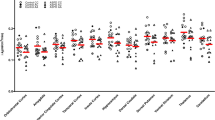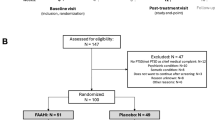Abstract
The endocannabinoid enzyme, fatty acid amide hydrolase (FAAH), has been proposed as a therapeutic target for alcohol use disorder (AUD) and co-morbid psychiatric illnesses. Investigating this target in the living human brain and its relationship to clinical outcome is a critical step of informed drug development. Our objective was to establish whether brain FAAH levels are low in individuals with AUD and related to drinking behavior. In this pilot study, treatment-seeking patients with AUD completed two PET scans with the FAAH radiotracer [C-11]CURB after 3–7 days (n = 14) and 2–4 weeks (n = 9) of monitored abstinence. Healthy controls (n = 25) completed one scan. FAAH genetic polymorphism (rs324420) and blood concentrations of anandamide and other N-acylethanolamines metabolized by FAAH were determined and AUD symptoms assessed. In AUD, brain FAAH levels were globally lower than controls during early abstinence (F(1,36) = 5.447; p = 0.025)) and FAAH substrates (anandamide, oleoylethanolamide, and N-docosahexaenoylethanolamide) were significantly elevated (30–67%). No significant differences in FAAH or FAAH substrates were noted after 2–4 weeks abstinence. FAAH levels negatively correlated with drinks per week (r = −0.57, p = 0.032) and plasma concentrations of the three FAAH substrates (r > 0.57; p < 0.04)). Our findings suggest that early abstinence from alcohol in AUD is associated with transiently low brain FAAH levels, which are inversely related to heavier alcohol use and elevated plasma levels of FAAH substrates. Whether low FAAH is an adaptive beneficial response to chronic alcohol is unknown. Therapeutic strategies focusing on FAAH inhibition should consider the possibility that low FAAH during early abstinence may be related to drinking.
Similar content being viewed by others
Log in or create a free account to read this content
Gain free access to this article, as well as selected content from this journal and more on nature.com
or
References
Parsons LH, Hurd YL. Endocannabinoid signaling in reward and addiction. Nat Rev Neurosci. 2015;16:579–94.
Cravatt BF, Giang D, Mayfield S, Boger D, Lerner R, Gilula N. Molecular characterization of an enzyme that degrades neuromodulatory fatty-acid amides. Nature 1996;384:83–7.
Patel S, Hill MN, Cheer JF, Wotjaki CT, Holmes A. The endocannabinoid system as a target for novel anxiolytic drugs. Neurosci Biobehav Rev. 2017;76:56–66.
Basavarajappa BS. The endocannabinoid signaling system: a potential target for next-generation therapeutics for alcoholism. Mini Rev Med Chem. 2007;7:769.
Sloan ME, Gowin JL, Ramchandani VA, Hurd YL, Le Foll B. The endocannabinoid system as a target for addiction treatment: trials and tribulations. Neuropharmacology 2017;124:73–83.
Basavarajappa BS, Joshi V, Shivakumar M, Subbanna S. Distinct functions of endogenous cannabinoid system in alcohol abuse disorders. Br J Pharm. 2019;176:3085–109. [Epub ahead of print]
Sloan ME, Gowin JL, Yan J, Schwandt ML, Spagnolo PA, Sun H, et al. Severity of alcohol dependence is associated with fatty acid amide hydrolase Pro129Thr missense variant. Addict Biol 2017;23:474–84.
Sipe JC, Chiang K, Gerber AL, Beutler E, Cravatt BF. A missense mutation in human fatty acid amide hydrolase associated with problem drug use. Proc Natl Acad Sci USA. 2002;99(12):8394–99.
Zhou Y, Huang T, Lee F, Kreek MJ. Involvement of endocannabinoids in alcohol “binge” drinking: studies of mice with human fatty acid amide hydrolase genetic variation and after CB1 receptor antagonists. Alcohol Clin Exp Res. 2016;40:467–73.
Vinod KY, Kassir SA, Hungund BL, Cooper TB, Mann JJ, Arango V. Selective alterations of the CB1 receptors and the fatty acid amide hydrolase in the ventral striatum of alcoholics and suicides. J Psychiatr Res. 2010;44:591–7.
Erdozain AM, Rubio M, Valdizan EM, Pazos A, Meana JJ, Fernández-Ruiz J, et al. The endocannabinoid system is altered in the post-mortem prefrontal cortex of alcoholic subjects. Addict Biol 2014;20:773–83.
Wilson AA, Garcia A, Parkes J, Houle S, Tong J, Vasdev N. [11C]CURB: Evaluation of a novel radiotracer for imaging fatty acid amide hydrolase by positron emission tomography. Nucl Med Biol. 2011;38:247–53.
Flannery BA, Volpicelli JR, Pettinati HM. Psychometric properties of the Penn Alcohol Craving Scale. Alcohol: Clin Exp Res. 1999;23:1289–95.
Sullivan J, Sykora K, Schneiderman J, Naranjo C, Sellers EM. Assessment of alcohol withdrawal: the revised Clinical Institute Withdrawal Assessment for Alcohol scale (CIWA-Ar). Br J Addict. 1989;84:1353–7.
Sobell L, Sobell M. Timeline follow-back: a technique for assessing self-reported alcohol consumption. In: Litten R, Allen JP, eds. Measuring Alcohol Consumption: Psychosocial and Biochemical Methods. New York, NY: Springer; 1992. p. 41–72.
Rusjan P, Wilson AA, Mizrahi R, Boileau I, Chavez S, Lobaugh NJ, et al. Mapping human brain fatty acid amide hydrolase activity with PET. J Cereb Blood Flow Metab. 2013;3:407–14.
Lin L, Metherel AH, Jones PJ, Bazinet RP. Fatty acid amide hydrolase (FAAH) regulates hypercapnia/ischemia-induced increases in n-acylethanolamines in mouse brain. J Neurochem 2017;142:662–71.
Boileau I, Tyndale RF, Williams B, Mansouri E, Westwood DJ, Le Foll B, et al. The fatty acid amide hydrolase C385A variant affects brain binding of the positron emission tomography tracer [11C]CURB. J Cereb Blood Flow Metab. 2015;35:1237–40.
Rusjan P, Mamo D, Ginovart N, Hussey D, Vitcu I, Yasuno F, et al. An automated method for the extraction of regional data from PET images. Psychiatry Res Neuroimaging. 2006;147:79–89.
Boileau I, Rusjan P, Williams B, Mansouri E, Mizrahi R, De Luca V, et al. Blocking of fatty acid amide hydrolase activity with PF-04457845 in human brain: a positron emission tomography study with the novel radioligand [11C]CURB. J Cereb Blood Flow Metab. 2015;35:1827–35.
Haile CN, Kosten TA. The peroxisome proliferator-activated receptor alpha agonist fenofibrate attenuates alcohol self-administration in rats. Neuropharmacology 2017;116:364–70.
Orio L, Alen F, Pavón FJ, Serrano A, Garcia-Bueno B. Oleoylethanolamide, neuroinflammation, and alcohol abuse. Front Mol Neurosci. 2019;11:490.
Kim H-Y, Spector AA. Synaptamide, endocannabinoid-like derivative of docosahexaenoic acid with cannabinoid-independent function. Prostaglandins Leukot Ess Fat Acids. 2013;88:121–5.
Rashid MA, Kim H-Y. N-Docosahexaenoylethanolamine ameliorates ethanol-induced impairment of neural stem cell neurogenic differentiation. Neuropharmacology 2016;102:174–85.
Garcia-Marchena N, Pavon FJ, Pastor A, Araos P, Pedraz M, Romero-Sanchiz P, et al. Plasma concentrations of oleoylethanolamide and other acylethanolamides are altered in alcohol-dependent patients: effect of length of abstinence. Addict Biol 2016;22:1366–77.
Mangieri R, Hong K-lA, Piomelli D, Sinha R. An endocannabinoid signal associated with desire for alcohol is suppressed in recently abstinent alcoholics. Psychopharmacol (Berl). 2009;205:63–72.
Henderson-Redmond AN, Guindon J, Morgan DJ. Roles for the endocannabinoid system in ethanol-motivated behavior. Prog Neuropsychopharmacol Biol Psychiatry. 2016;65:330–9.
Vinod K, Maccioni P, Garcia-Gutierrez M, Femenia T, Xie S, Carai MAM, et al. Innate difference in the endocannabinoid signaling and its modulation by alcohol consumption in alcohol-preferring sP rats. Addict Biol. 2012;17:62–75.
Blednov YA, Cravatt BF, Boehm SL, Walker D, Harris RA. Role of endocannabinoids in alcohol consumption and intoxication: studies of mice lacking fatty acid amide hydrolase. Neuropsychopharmacology 2007;32:1570–82.
Vinod KY, Sanguino E, Yalamanchili R, Manzanares J, Hungund BL. Manipulation of fatty acid amide hydrolase functional activity alters sensitivity and dependence to ethanol. J Neurochem 2008;104:233–43.
Zhou Y, Schwartz BI, Giza J, Gross SS, Lee F, Kreek MJ. Blockade of alcohol escalation and “relapse” drinking by pharmacological FAAH inhibition in male and female C57BL/6J mice. Psychopharmacology 2017;234:2955–70.
Stopponi S, Fotio Y, Domi A, Borruto AM, Natividad L, Roberto M, et al. Inhibition of fatty acid amide hydrolase in the central amygdala alleviates co-morbid expression of innate anxiety and excessive alcohol intake. Addict Biol 2017;23:1223–32.
Pavon FJ, Serrano A, Stouffer DG, Polis I, Roberto M, Cravatt BF, et al. Ethanol-induced alterations in endocannabinoids and relevant neurotransmitters in the nucleus accumbens of fatty acid amide hydrolase knockout mice. Addict Biol 2018;24:1204–15.
Solinas M, Justinova Z, Goldberg SR, Tanda G. Anandamide administration alone and after inhibition of fatty acid amide hydrolase (FAAH) increases dopamine levels in the nucleus accumbens shell in rats. J Neurochem 2006;98:408–19.
Scherma M, Medalie J, Fratta W, Vadivel S, Makriyannis A, Piomelli D, et al. The endogenous cannabinoid anandamide has effects on motivation and anxiety that are revealed by fatty acid amide hydrolase (FAAH) inhibition. Neuropharmacology 2008;54:129–40.
John GR, Littleton JM, Nhamburo PT. Increased activity of Ca2+-dependent enzymes of membrane lipid metabolism in synaptosomal preparations from ethanol-dependent rats. J Neurochem 1985;44:1235–41.
Maccarrone M, Salvati S, Bari M, Finazzi-Agrò A. 2-Arachidonoylglycerol inhibit fatty acid amide hydrolase by activating the lipoxygenase pathway of the arachidonate cascade. Biochem Biophys Res Commun. 2000;278:576–83.
Sloan ME, Grant CW, Gowin JL, Ramchandani VA, Le Foll B. Endocannabinoid signaling in psychiatric disorders: a review of positron emission tomography studies. Acta Pharm Sin. 2019;40:342–50.
Hirvonen J, Zanotti-Fregonara P, Umhau JC, George DT, Rallis-Frutos D, Lyoo CH, et al. Reduced cannabinoid CB1 receptor binding in alcohol dependence measured with positron emission tomography. Mol Psychiatry 2013;18:916–21.
Ceccarini J, Hompes T, Verhaeghen A, Casteels C, Peuskens H, Bormans G, et al. Changes in cerebral CB1 receptor availability after acute and chronic alcohol abuse and monitored abstinence. J Neurosci 2014;34:2822–31.
Burstein SH, Huang SM, Petros TJ, Rossetti RG, Walker JM, Zurier RB. Regulation of anandamide tissue levels by N-arachidonylglycine. Biochemical Pharmacol 2002;64:1147–50.
Long LE, Lind J, Webster M, Weickert CS. Developmental trajectory of the endocannabinoid system in human dorsolateral prefrontal cortex. BMC Neurosci 2012;13:87.
Rodríguez de Fonseca F, Cebeira MR, J A, Martín M, Fernández-Ruiz J. Cannabinoid receptors in rat brain areas: sexual differences, fluctuations during estrous cycle and changes after gonadectomy and sex steroid replacement. Life Sci 1994;54:159–70.
Acknowledgements
None.
Funding and Disclosures
This study was supported in part by the National Institute of Health and National Institute of Drug Abuse (NIH/NIAAAR21 1R21AA022246-01A1 (IB)), the Ontario Mental Health Foundation (IB), Canadian Institutes of Health Research Project Grant (PG-389342 (IB)); a Canada Research Chairs program (the Canada Research Chair in Pharmacogenomics (RFT)), Canadian Institutes of Health Research (Foundation grant FDN-154294 (RFT)); CIHR TMH109787 (RFT); funding from the Canadian Institutes of Health Research (RPB), the Natural Sciences and Engineering Research Council of Canada (RPB), the Canada Research Chair in Brain Lipid Metabolism (RPB); the Canada Foundation for Innovation and the Ontario Ministry of Research and Innovation (SH); a Canadian Institutes of Health Research Doctoral Award—S Frederick Banting and Charles Best Canada Graduate Scholarships (CGS-D (LMB)), the Centre for Addiction and Mental Health and the CAMH Foundation. The authors disclose the following financial relationships: Laura M. Best is supported by a Canadian Institutes of Health Research Doctoral Award—S Frederick Banting and Charles Best Canada Graduate Scholarships (CGS-D); Belinda Williams discloses no biomedical financial interests or potential conflicts of interest. Dr Le Foll has/will received some in-kind donation of cannabis product from Canopy and Aurora, and medication donation from Pfizer and Bioprojet, and was provided a coil for TMS study from Brainsway. Dr Le Foll has/will perform research with industry funding obtained from Canopy (through research grants handled by CAMH or University of Toronto, Aphria (through research grants handled by CAMH or University of Toronto), Bioprojet, ACS, and Alkermes. Dr Le Foll has received in-kind donations of nabiximols from GW Pharma for past studies funded by CIHR and NIH. Esmaeil Mansouri discloses no biomedical financial interests or potential conflicts of interest. Dr Richard P Bazinet received funding from the Canadian Institutes of Health Research, the Natural Sciences and Engineering Research Council of Canada, and is the Canada Research Chair in Brain Lipid Metabolism. RPB has received industrial grants, including those matched by the Canadian government, and/or travel support related to work on brain fatty acid uptake from Arctic Nutrition, Bunge Ltd., DSM, Fonterra, Mead Johnson, and Nestec, Inc. Moreover, RPB is on the executive of the International Society for the Study of Fatty Acids and Lipids, and held a meeting on behalf of Fatty Acids and Cell Signaling, both of which rely on corporate sponsorship. RPB has given expert testimony in relation to supplements and the brain. Dr Lin Lin discloses no biomedical financial interests or potential conflicts of interest. Dr Vincenzo De Luca discloses no biomedical financial interests or potential conflicts of interest. Dr Dina Lagzdins discloses no biomedical financial interests or potential conflicts of interest. Dr Pablo Rusjan discloses no biomedical financial interests or potential conflicts of interest. Dr Rachel F. Tyndale has undertaken this research, in part, thanks to funding from the Canada Research Chairs program (Dr Tyndale, the Canada Research Chair in Pharmacogenomics) a Canadian Institutes of Health Research (Foundation grant FDN-154294); the Centre for Addiction and Mental Health and the CAMH Foundation. RF Tyndale has consulted for Ethismos on unrelated topics. RF Tyndale has also received research grant support from a Global Research Awards for Nicotine Dependence (GRAND), an independently reviewed competitive grants program supported by Pfizer; Dr Alan A Wilson discloses no biomedical financial interests or potential conflicts of interest; Dr Christian Hendershot discloses no biomedical financial interests or potential conflicts of interest; Dr Markus Heilig discloses no biomedical financial interests or potential conflicts of interest; Dr Sylvain Houle discloses no biomedical financial interests or potential conflicts of interest. Dr Sylvain Houle has received funding from the Canada Foundation for Innovation and the Ontario Ministry of Research and Innovation; Dr Junchao Tong discloses no biomedical financial interests or potential conflicts of interest; Dr Stephen Kish receives a salary from the Centre for Addiction and Mental Health. During the past 36 months, he has been awarded as PI research grants from US NIH R21DA040066 and R21AA026680, and an investigator sponsored research grant from Jazz Pharmaceuticals aimed at understanding the possible involvement of dopamine in the actions of the drug Xyrem. He is co-investigator on a research grant entitled “Microglial activation in major depressive disorder: Relationship to comorbidity and loss of synaptic density” from the Canadian Institutes of Health Research; Dr Isabelle Boileau received funding from the National Institute of Health and National Institute of Drug Abuse (NIH/NIAAAR21 1R21AA022246-01A1 and the Ontario Mental Health Foundation to complete this research. Dr Isabelle Boileau has also received funding from the National Institute of Health (Co-I, R21AA026680; PI, 1R21DA04529), Canadian Institutes of Health Research (PI), the Caskey Francis Award (PI), and the Canadian Institute for Military and Veterans Health Research (PI) to complete other research projects.
Author information
Authors and Affiliations
Corresponding author
Additional information
Publisher’s note Springer Nature remains neutral with regard to jurisdictional claims in published maps and institutional affiliations.
Co-senior author: Stephen J. Kish
Supplementary information
Rights and permissions
About this article
Cite this article
Best, L.M., Williams, B., Le Foll, B. et al. Lower brain fatty acid amide hydrolase in treatment-seeking patients with alcohol use disorder: a positron emission tomography study with [C-11]CURB. Neuropsychopharmacol. 45, 1289–1296 (2020). https://doi.org/10.1038/s41386-020-0606-2
Received:
Revised:
Accepted:
Published:
Issue date:
DOI: https://doi.org/10.1038/s41386-020-0606-2
This article is cited by
-
Radiopharmaceuticals and their applications in medicine
Signal Transduction and Targeted Therapy (2025)
-
Peripheral endocannabinoids in major depressive disorder and alcohol use disorder: a systematic review
BMC Psychiatry (2024)
-
Endocannabinoids and related lipids linked to social exclusion in individuals with chronic non-medical prescription opioid use
Neuropsychopharmacology (2024)
-
Mit PET-Bildgebung psychischen Erkrankungen auf der Spur
InFo Neurologie + Psychiatrie (2024)
-
Circulating endocannabinoids and genetic polymorphisms as predictors of posttraumatic stress disorder symptom severity: heterogeneity in a community-based cohort
Translational Psychiatry (2022)



